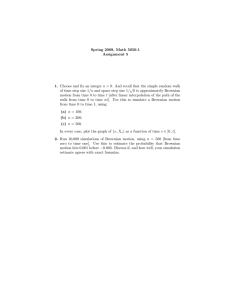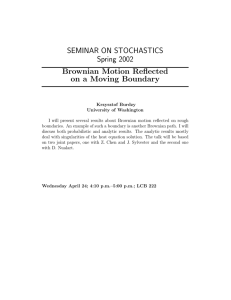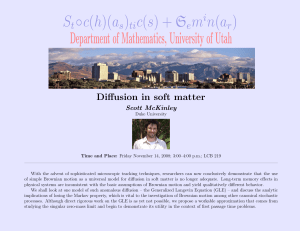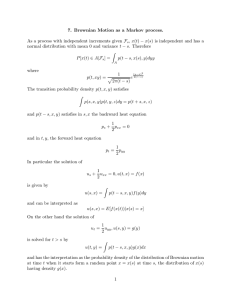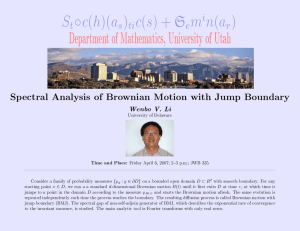Monte Carlo Solving problems using random number generation. measuring the
advertisement
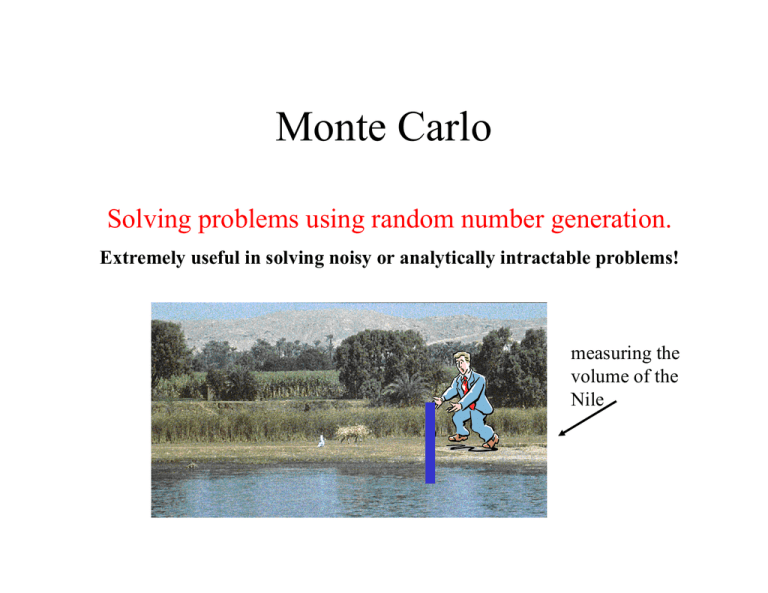
Monte Carlo
Solving problems using random number generation.
Extremely useful in solving noisy or analytically intractable problems!
measuring the
volume of the
Nile
Useful information you can get after
doing many trials of your system:
Mean:
Standard Deviation:
Integral evaluation:
Other stuff…
P(xi) estimated from your trials as:
#sightings of xi / total # trials
num trials
mean
Get information about biological
systems!
Molecular Monte Carlo lets you explore many
interesting properties…
thermally-averaged structures
molecular charge distributions
reaction rate constants
free energies
dielectric constants
heat capacities
phase transition temperatures
just about anything.
Easier things to try right now
We can use Monte Carlo to estimate a whole
probability distribution function that might
otherwise be very difficult to compute
Or, we can take a predefined distribution
function and randomly draw numbers from it
to learn things about the distribution
Generating random numbers
from a specific distribution
• Almost always start by drawing random numbers
from a uniform distribution where all values
between 0 and 1 are equally likely
• Many programming languages have such
“random” number generators built-in
MATLAB random number
generators
• MATLAB has a ton of built-in random
number generators so that you don’t have to
worry about the algorithms
• A great demo of these generators is
randtool.m
• You can try it out by typing ‘randtool’ at the
matlab prompt in MIT server
Polymerase Chain Reaction: A brief
introduction
• Denaturation:
– Heat sample to 94oC to
denature the DNA
• Annealing
– Add primers
– Reduce temp. to 54oC
• Extension
– Increase temp. to 72oC
– Add dNTPs and thermophilic
polymerase (Taq)
• And repeat!
Pcrsteps.gif
How can we represent PCR
statistically?
PCR is an example of a
branching process. During
each cycle of the reaction, we
can generate one or two
“branches” for each existing
copy of DNA (i.e. each strand
either gets copied or it
doesn’t)
Scary model for PCR
Probability that PCR tube contains n1 copies given that we
started with n0:
⎛ n0 ⎞ n1 − n0
⎟⎟ε
(1 − ε )2 n0 −n1
P (n1 | n0 {ε }) = ⎜⎜
⎝ n1 − n0 ⎠
Apply Bayesian sum and product rule:
P( A | C ) = ∑ P( A | B) P( B | C )
B
And obtain an expression for the probability that after k
cycles the tube contains nk copies:
P(nk | n0 {ε }) = ∑∑L∑ P (nk | nk −1{ε }) P (nk −1 | nk − 2 {ε })L P(n1 | n0 {ε })
nk −1 nk −2
n1
Brownian motion and diffusion
• Brownian motion: the constant and seemingly
random motion of particles due to the kinetic
energy imparted on one another as they collide
• Diffusion: the macroscopic phenomenon by
which we observe the spreading out of
particles in space due to accumulated
Brownian motion
http://www.phys.virginia.edu/classes/109N/more_stuff/Applets/brownian/brownian.html
Brownian Motion
• Not really random—if knew the location
and velocity of every particle we could
predict trajectories at any later time
• Realistically this is impossible for system
with large number of particles
• Describe by the random walk

